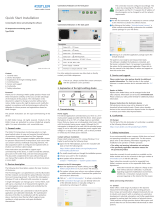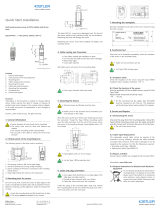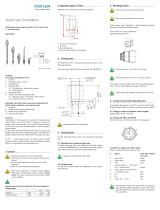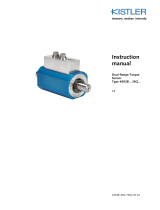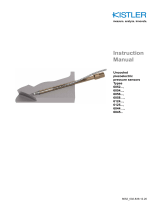Page is loading ...

Instruction
Manual
6909_002-173e-02.22
Pressure Pulse
Generator
Type 6909

Page 1
6909_002-173e-02.22
Thank you for choosing a Kistler quality product
characterized by technical innovation, precision and long
life.
Information in this document is subject to change without
notice. Kistler reserves the right to change or improve its
products and make changes in the content without
obligation to notify any person or organization of such
changes or improvements.
© 2021 ... 2022 Kistler Group. Kistler Group products are
protected by various intellectual property rights. For more
details visit www.kistler.com. The Kistler Group includes
Kistler Holding AG and all its subsidiaries in Europe, Asia,
the Americas and Australia.
Kistler Group
Eulachstrasse 22
8408 Winterthur
Switzerland
Tel. +41 52 224 11 11
info@kistler.com
www.kistler.com
Foreword
Foreword

Pressure Pulse Generator
6909_002-173e-02.22Page 2
Contents
1. Introduction .................................................................................................................................3
2. Hints on the use of these Operating Instructions ....................................................................4
3. General description of the equipment ......................................................................................5
4. Operation .....................................................................................................................................7
4.1 General information ............................................................................................................7
4.2 Start-up ...............................................................................................................................7
4.3 Location ..............................................................................................................................8
4.4 Performing drop tests .........................................................................................................8
4.5 Exchanging the adapter ......................................................................................................8
4.6 Supporting the drop weight .................................................................................................9
4.7 Limiting the drop height ......................................................................................................9
5. Operating faults, notes .............................................................................................................10
5.1 Air inclusions ....................................................................................................................10
5.2 Defective seal ...................................................................................................................10
6. Equipment supplied ..................................................................................................................12
6.1 Accessories available .......................................................................................................12
7. Technical data ...........................................................................................................................13
Total pages 13

Introduction
Page 3
6909_002-173e-02.22
1. Introduction
Thank you for choosing a quality product from Kistler.
Please read through this manual thoroughly to enable you
to fully exploit the various features of your product.
To the extent permitted by law Kistler accepts no liability
if this instruction manual is not followed or products other
than those listed under Accessories are used.
Kistler oers a wide range of measurement products
through to turnkey solutions:
Piezoelectric sensors for measuring pressure, force,
torque, strain, acceleration, shock and vibration
Strain gage sensor systems for measuring force and
torque
Piezoelectric pressure sensors and transmitters with
matching measuring ampliers
Matching measuring ampliers (charge ampliers,
piezoresistive ampliers, etc.), displays and charge
calibrators
Electronic control, monitoring and evaluation units as
well as software for specic measurement applications
Data transmission modules (telemetry)
Kistler also develops and produces measuring solutions
for the application elds engines, vehicles, manufacturing,
plastics and biomechanics sectors.
Our product and application brochures will provide you
with an overview of our product range. Detailed data
sheets are available for almost all products.
If you need additional help beyond what can be found
either on-line or in this manual, please contact Kistler‘s
extensive support organization.

Pressure Pulse Generator
6909_002-173e-02.22Page 4
2. Hints on the use of these Operating Instructions
These instructions describe the pressure pulse generator
Type 6909.
Please keep these operating instructions in a safe place
where you can retrieve them at any time.
The current version of this document may be downloaded
from Kistler.com
Details and information in these instructions are subject to
change at any time without prior notice.

General description of the equipment
Page 5
6909_002-173e-02.22
3. General description of the equipment
Equipment for the generation of pressure pulses from
about 25 to 5 000 bar. The pressure pulse generator can
be used to test pressure sensors dynamically without
complication. Compared with static calibration, the
sensors are exposed only briey to a high pressure.
Pressure is generated by means of a dropping weight
which drops onto the piston of an oil-lled pressure
chamber. The pressure pulse thereby produced acts
on the sensors screwed into the pressure chamber
(adapter).
The dropping weight is inserted into a tube and, by
means of a lifting device with a scale, is raised by hand to
the desired dropping height and allowed to drop.
The pressure chamber consists of a piston-cylinder unit
and an interchangeable adapter with 2 mounting holes for
Kistler pressure sensors.
Fig. 1: Pressure pulse generator

Pressure Pulse Generator
6909_002-173e-02.22Page 6
Fig. 2: Main dimensions
Main parts:
1 Base plate 218 x 190 x 28
2 Spacer D65 x 30
3 Adapter 6931A...
4 Piston-cylinder unit
5 Drop tube base D85 x 20
6 Drop weight
7 Drop tube D85/80 x 460
8 Handle D28, black
28
58
572
25
40
86
218
/190
27
8
6
7
2
1
5
4
3

Operation
Page 7
6909_002-173e-02.22
4. Operation
4.1 General information
For pressure pulses up to about 500 bar, only the
aluminum rod is used as drop weight (Kistler Material
65013682).
For pressure pulses > 500 bar, the drop weight of 5,4 kg
is used (Kistler Material 65013680).
NOTE
For sensors with a pressure range < 500 bar, the drop weight
of 5,4 kg must not be used, otherwise there is a risk that the
sensor will be overloaded or even damaged beyond repair!
4.2 Start-up
Tilt the generator horizontal so that the mounting holes
of the adapter point upwards.
Screw in reference sensor with prescribed torque into
adapter Type 6931A...
Turn the generator 180° through its axis so that the
opposite mounting hole is on top.
Check that the piston is pressed fully downwards. If
not, slide the piston with the drop weight downwards.
Fill oil (Type 1053) into the hole with a pipette until the
thread is completely covered.
Gradually screw the test sensor by hand completely
into the adapter Type 6931A. The pressure produced
automatically slides the piston upwards into the correct
position. Remove excess oil.
Unscrew the test sensor and ll once more with oil
until about 1/3 of the thread is covered.
Gradually screw in the test sensor to vent the
remaining air and tighten to the prescribed torque.
Bring the generator into the vertical operating position.
Unscrew the drop tube cover and insert the drop
weight into the drop tube.
- For pressure pulses up to about 500 bar, t the
insert with the aluminum rod into the drop tube.
- For pressure pulses > 500 bar, screw the drop
weight onto the thread of the lifting device (steel
bar) and insert the drop weight into the drop tube.
Connect measuring chain.

Pressure Pulse Generator
6909_002-173e-02.22Page 8
4.3 Location
To obtain ideal operation, i.e. max. pressures, shortest
pulse duration and good recoil of the drop weight, the
pressure pulse generator must be set up on a at and
hard base (e.g. steel plate, concrete oor).
Good recoil allows the weight to be caught again with the
hand after the initial impact on the piston.
4.4 Performing drop tests
The pressure generated is not proportional to the drop height,
i.e. even very low drop heights produce high pressure, and
the pressure rises only slightly with increasing drop height.
It is therefore advisable to begin testing with very low drop
heights and gradually to increase the drop height.
WARNING
If pressure sensors with a pressure range of < 5 000 bar are
used, there is a danger when using the drop weight (5,4 kg)
that the permissible pressure range will be exceeded and the
sensors damaged beyond repair.
Pressure sensors with a pressure range of < 500 bar must not be
tested with the drop weight 5,4 kg but only with the aluminum rod.
With pressure sensors with a pressure range of up to 250 bar,
testing must be started with a drop height of not more than 5 cm.
4.5 Exchanging the adapter
Unscrew the 4 hexagonal slot screws M4 at the base
of the drop tube.
Remove drop tube and drop weight.
Unscrew the 4 hexagonal slot screws M8.
Remove the drop tube base
Withdraw the piston-cylinder unit from the adapter.
Fit new seal Type 1101B in the adapter and push
together with the piston-cylinder unit. It is advisable
to apply a light lm of grease to the tting surface to
increase adhesion between the parts.
Slide the piston up to the limit stop in the adapter.
Then t the adapter and piston-cylinder unit onto the
intermediate adapter.
Place the drop tube base in position, screw in the
4 x M8 hexagonal slot screws by hand and then
tighten them with the wrench in stages by tightening
opposite pairs of screws in turn until all screws are
fully tightened.
Fit the drop tube and screw in position.

Operation
Page 9
6909_002-173e-02.22
4.6 Supporting the drop weight
Insertion of the support ring (Kistler Material 65000013)
between handle and drop tube cover ensures that the
drop weight does not rest on the piston and cause oil to
be squeezed out of the pressure chamber.
4.7 Limiting the drop height
In order to protect the sensors against overload, the
drop height of the 5,4 kg drop weight can be limited by
clamping a circlip (Kistler Material 65013337) as a limit
stop on the piston rod.
Unscrew the 4 hexagon screws M4 in the drop tube
cover
Remove the drop tube cover and piston rod
Ax the circlip in the corresponding notch in the piston
rod.
Mount the drop tube and screw in position.

Pressure Pulse Generator
6909_002-173e-02.22Page 10
5. Operating faults, notes
5.1 Air inclusions
Air inclusions in the pressure chamber cause pressure
uctuations during the pressure rise.
Remedy:
Dismantle the test sensor, top up with oil and screw the
sensor back in as described in paragraph 4.2.
Fig. 3: Pressure curve with air inclusion
5.2 Defective seal
If the drop weight strikes without producing pressure after
only a few strikes (5 ... 10), then the seal Type 1101B of
the piston-cylinder unit or that of the sensor is damaged.
A leaking system can also be recognized by a pressure
curve which is not sinusoidal.
Remedy:
Exchange defective seal.

Operating faults, notes
Page 11
6909_002-173e-02.22
Fig. 4: Pressure curve with leaking seal Type 1101B
In order to obtain max. pressure pulses, the drop weight
must slide smoothly in the tube. If there is a noticeable
resistance in the movement of the drop weight, the piston
must be lubricated with oil.
Continuous loading of the piston by the drop weight will
cause oil loss. The drop weight should therefore not be
allowed to remain resting on the pressure piston for a
lengthy period.

Pressure Pulse Generator
6909_002-173e-02.22Page 12
6. Equipment supplied
High pressure oil Type 1053
Klüber grease Type 1063
10 seals Type 1101B
Seeger circlip pliers 65007815
Support ring 65000013
Pipette 65007816
Wrench SW3 65007763
Wrench SW8 65007817
Drop weight up to 5 000 bar 65013680
Drop weight up to 500 bar 65013682
5 x circlips 65013337
6.1 Accessories available
Working standard Type 6213B
Adapter M12x1/M10x1 shoulder seal 6931A1/18006807
Adapter M12x1/M10x1 front seal 6931A2/18006808
Adapter M12x1/M12x1 6931A3/18006809
Adapter M14x1.25/M14x1,25 6931A4/18006810
Adapter M14x1.25/M10x1 6931A5/18006811
Adapter M10x1/M10x1 6931A6/18006812
Adapter M7x0.75 (4pc.) 6931A7/18033741
Adapter M12x1/M10x1 6931A8/18036713
Adapter M12x1/3/8-24UNF 6931A9/18036714

Technical data
Page 13
6909_002-173e-02.22
7. Technical data
Range bar 25 ... 5 000
Pulse width ms 5 ... 10*
Drop weight 25 ... 500 bar
500 ... 5 000 bar
g
g
130
5 400
Oil volume cm30,5
Pressure transmission
(by hydraulic oil)
Type 1053
Weight kg 14,6/19
Total height mm ≈ 600
Width mm ≈ 218
Drop tube diameter mm 86
Drop height mm ≤ 320
* Pulse width is dependent on the adapter
8. Warranty
Regarding the warranty reference is made to the
agreement between the respective contracting parties.
/
